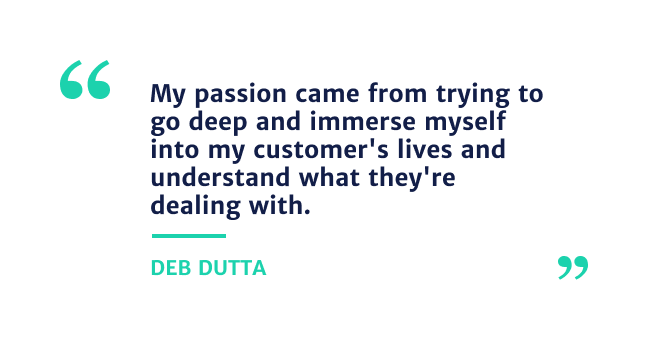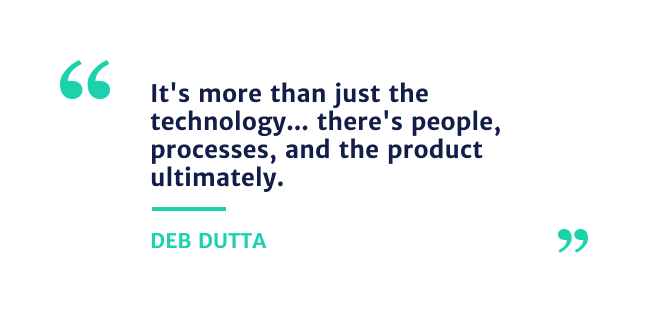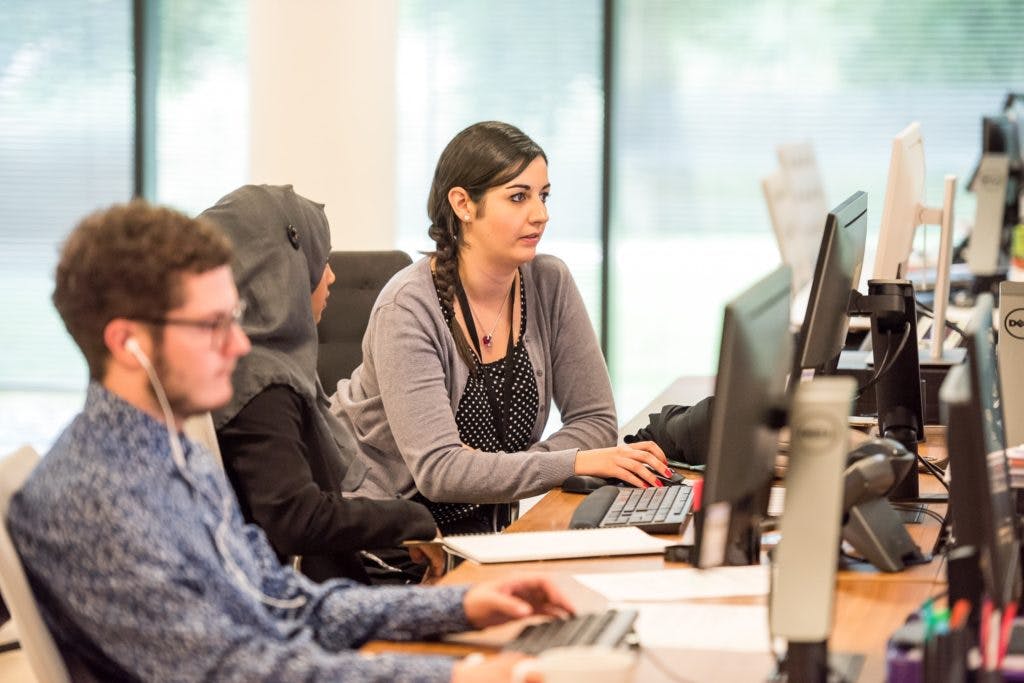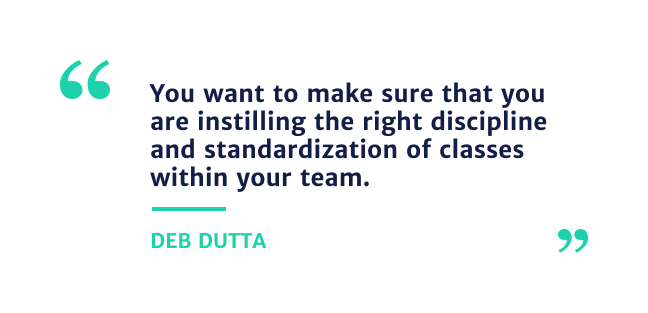Season 4 - Episode 1
Basing Decisions on Data
Deb Dutta is currently Group Product Manager at Paypal, an e-commerce platform that allows and facilitates online payments between its users. Deb talks us through her journey into the product industry, helping others in her community, empowering Product Managers, and more.

Watch the episode here: Basing Decisions on Data
“Question [00:00:16] How did you end up breaking through product? What’s your story? ”
Deb [00:00:20] So I’ll go a little bit back. I’m an Indian woman of color. Today I lead a talented group of product managers at PayPal. We’re focused on transforming PayPal’s entire customer success agent experiences to go from a transaction service model to AI predictive, human-centric servicing model, and so on.
So truthfully, I started as I came to this country about 12 years ago to study engineering at Carnegie Mellon. Then I got my first job at Microsoft. And over the years I’ve realized where my passion is, Product Managers and anybody in the deck looking to solve the hard problems. My passion came from trying to go deep and immerse myself into my customer’s lives and understand what they’re dealing with and look at problem-solving from the customer’s lens.

So I started, breaking into Product Ownership back at Cisco. And then I got my first big gig at Hitachi and got to work on a Product Management portfolio for fighting crime. Believe me, that was my first experience whereas someone who has no experience of this background, how human-centricity customer centricity can enable you to build kick-ass products. And then eventually my journey came into PayPal where Today like I said, I led a product for our customer service agent experiences.
“Question [00:04:34] How do you go about picking those problems that you are passionate about? ”
Deb [00:04:41] To be quite honest, it depends really which stage of the journey you are in. Like I said to me, Product Management is it’s almost like a gift to be in a Product Manager’s position. As a leader in this space, you get to view things from multiple lenses. So one example was my first time taking on a project where we had to learn what kind of a solution can I create to provide law enforcement agencies that it’s on their shoulders. They’re, looking to fight crime. They’re looking at arming their first responders with the right toolkit so that they can do their job. We don’t want our products to be things that they have to learn and figure it out. We wanted to enable our customers to do what they want to do best.
So in terms of, when you look at it from that lens, you learn that it’s more than just the technology. You do learn that on the product, there’s people, processes, and the product ultimately. So your thinking about a product and their thinking about their pain points, you’re looking at where the industry going. When you’re looking to enable products that solve your customer’s problems next, you need to figure out how to build them or how to even design them. So having a human-centric approach, which is one of my favorite things that I and my team do constantly we do a lot of disability studies and very constantly get into feedback on our solutions from our customers.

And then the next thing is also about analytics. While you’re learning some of this there are just so many problems to solve. How do you look at what problems can you solve in a way that drives the maximum impact? Making data-driven decisions, having analytics as part of your discipline, so that you are identifying growth opportunities. And then as you evolve, like in that journey, you learn about one. It’s not just about the customer problem. It’s not just about the solution. It’s about the people that you are taking along with you. Who are your stakeholders across functional partners, who do you need with you on this journey to deliver that vision? Relationships with your partners and people that you work with are incredibly critical. And I would say a process, but having the true process. Having the appropriate processes. The diligence for every single Product Manager to follow the process to build, measure, and learn so that you’re building out products that continue to sort of sustain and retain customer retention. I think is critical. I mean, there’s just so many things to it. I love the whole process and the discipline of what it takes to be a product manager.
You might also be interested in: Understand Customer Problems by the Foundry PM

“Question [00:09:46] How do you split your time between your full-time job and helping so many people in your community?”
Deb [00:09:58] I think one of the biggest things that are discouraging women from entering the space of product in tech is lack of mentors, lack of role models because a lot of times you need to work toward the MarketStar and a lot of people, even if you have that dream, you need a network that enables and supports you. When you have questions when you’re feeling like you need someone to energize you. I think that women honestly, one big thing about women in product is to give that platform. Not, everybody needs to be in a very senior leadership role to be a support element. Women, with today’s example, are not getting promoted into senior tech roles because the thing that we always need sponsorship at a senior leadership level, well, that’s valid and true. I think it’s also important to know that you need to be surrounded by people who either are with you on this journey. You have people to collaborate with. You have people who you can give access to women who are seeking that growth with women who have made it or in some ways have made it.
Women in product is an opportunity where we connect all of us, we all have growth ideas, with some people who inspire us. And I think that’s one of the ways that we are trying to educate all of us and everybody in this network about the demands of the industry. We’ve read a lot about times women are deterred from entering the tech space because either they think that they’re not technical enough, or they think that they don’t have the right skills, or it could just be the factor that, Silicon Valley traditionally, or tech companies traditionally have had this whole idea that they are trying to attract youngsters who have, happy hour and free food is the attraction.
And that’s not true. The industry has evolved. And a lot of companies, I know my own company does a lot of things in terms of enabling childcare, healthcare, flexible, working for parents. These are the things that attract and give comfort to women to join us. So I think it is important that we create these forums to share what different countries are doing what those initiatives are. Lastly, for me, it’s so motivating just to have this connection and what Product School is for me, it’s like reaching out to so many more to share this vision. I will do whatever I can to make room and time for it.

“Question [00:18:17] How can you empower product managers that report to you to think strategically and own more pieces of the puzzle? ”
Deb [00:18:30] What I tried to do is, different people are different, but broadly people tend to function well when you provide a structure. So the first thing I did as a Product Manager was to assess the level that each Product Manager is at. And everybody has skills. To be honest, some people are empathetic and appreciate the customer. Some people are very data-driven. Some people are quick with design and creativity. So you want to make sure that one, you are instilling the right discipline and standardization of classes within your team. And the second thing is ensuring that you are tapping into each strength. So largely what I recommend for any Product Manager as I’m doing even for my own company, is start with the stages in your journey.

Start with product requirements and your product requirements, actually put pen to paper, write the priority. So first starting back, you want to go ahead and do some customer research. You want to talk to your users, you want to see how they’re using their tools, do some journey, mapping, story mapping, but ultimately you want all of these to evolve into a product requirements document. Now I know a lot of people have moved on from PRDs and so on. So you can have your version of what that is, but what I’m essentially asking is everybody, I would encourage them. I do encourage my team to document, what are your objectives? What are you trying to do this? Who are your customer segments? Who are the personas, or actors? Describe their pain points or use cases. And then it will come up with what your requirements are to solve those use cases and talk about what those metrics would be to measure success. Simple. It’s something as simple as this is extremely valuable to convey your thoughts into a document.
The second thing I’d recommend is if you are handy enough, or if you have access to a user research and user experience group, is to connect with them to walk through your requirements, or sometimes even bring them along with you in the journey to learn and hear from the user. Because ultimately you want your requirements translated into, if you’re in a consumer-facing product, you want it to get translated into designs that you can ultimately take to your end-users, get validity, and using the testing on someone. The second thing, the bid helps you with is engineering communication, explain to them what your thought processes, because then they are going to take that and convert it into technical design and ultimately implement.
So I think it’s important to articulate and refine and review exactly what you want to deliver. Once you have that, this is an interest of build, measure, learn the process. So as you’re evolving designs, we take it back to our end-users, before the pilot. We get some early feedback through usability studies. Once we are ready to pilot, we do, we call it pilot because what we do is a form of A/B testing where you don’t roll out first, you test to see the metrics that you’re looking to capture at the end of the day. You want to see which treatment is delivering the type of experience you want before you roll this out broadly. Hookup tools like Tableau and so on, for reporting and capturing metrics, make sure you’re significantly instrumented so that you’re capturing metrics from the day you go live use, Judah, for agile, so that you’re constantly keeping an eye on what you’re able to pivot as many issues come up and you’re able to be very agile.
I think some of these things that are simple to be quite honest, but important to follow that discipline, sometimes it sounds like a pain. And I know when I joined my team, my team was like, “Wow, she comes with a lot of processes” but today they do this on their own. I don’t even have to ask them just because it brings a sense of trust, credibility to the work that you’re bringing to the table. Word of mouth is very different from something that’s documented., so I highly recommend that.
You might also be interested in: Expertise Without Experience: 3 Ways to Manage an Established Team as a New Product Manager
We’ll be back next week with Agatha Krajewski from Shopify with even more of the latest insights from the Product Management world.
Listen to our episodes on your favorite platform
Stay tuned for new episodes
By sharing your email, you agree to our Privacy Policy and Terms of Service






